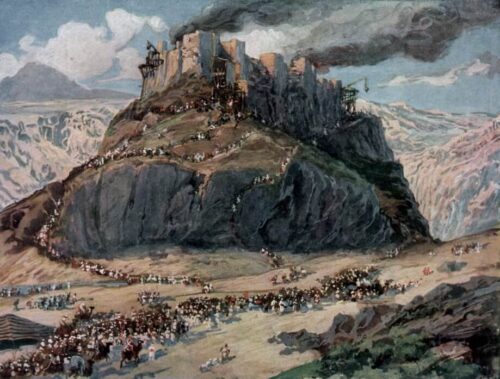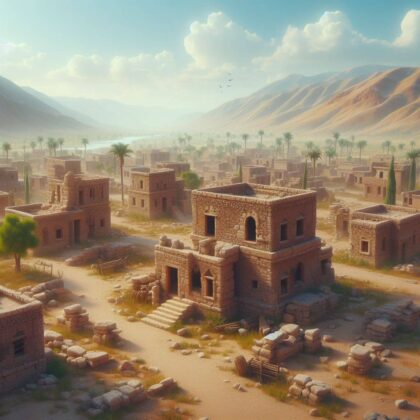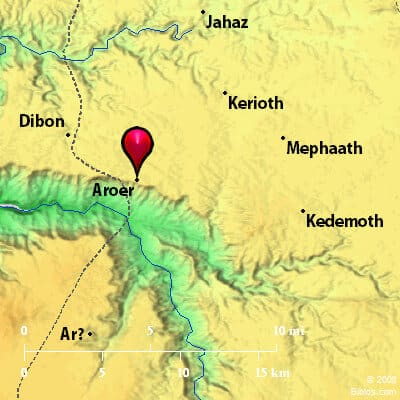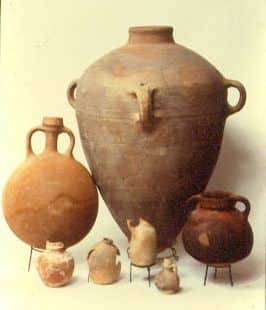Aroer is the name given to three cities mentioned in the biblical Old Testament. Two of these cities are east of the Jordan River, in the region of Gilead or close to it. The other city is found in the territory of Canaan, in the tribe of Judah.
Each of the cities is mentioned at different times in the history of ancient Israel, in moments of conquest of the land and in moments of the Israeli monarchy.
The best known is certainly the city that is on the banks of the river arnom, mentioned during the battles of conquest of Gilead, as the southern border of the tribe of Rubem and during the reports of the Israelites’ battles against the Ammonites, when the Judge Jephthah judged the people.
Aroer of the Tribe of Rubem, on the Arnom River
Aroer of the Tribe of Rubem, was a biblical city located on the banks of the arnon river, in the territory today belonging to Jordan.
Aroer Foundation of the Arnom River
According to Mesha EstelA, also called the Moabite stone, the city was originally founded by the Moabites, a people that descended Lot and who inhabited the mountains of Moab, a region east of the Dead Sea.
It is believed that its foundation took place around the 1650s BC. Its location on the banks of the river guaranteed the protection of the Moabite territory to the south of the Arnom, as well as the water supply and the irrigation of the farms of the city’s residents.
Conquest of Aroer by the Amorites
Around the year 1550 BC, the Amorites dominated the entire ancient region of Gilead, from the Sea of Galilee to the north and the Jarmuk River, to the Arnom River to the south. Eventually and the city was conquered and fortified by the Amorites.
Aroer was extremely important for the defense of the dairy lands. Due to its importance, the city was the reason for a dispute between the Moabites and Amorites for several years, until the Israelite domination of the region.
The city was also close to an old commercial route, called King’s Road. In addition to its importance for the defense of the land, it was important for the trade of the people who dominated it.

Aroer Israeli Aroer Conquest of the Arnom River
The city of Aroer was conquered by the Israelites around 1450 BC, when they wandered through the desert to the Promised Land, Canaan.
The biblical text narrates that Israel asked for a quiet passage through the lands of the Amorites to the king seom, which ruled the city of Hesbon and had control of all the cities south of Gilead and close to the river arnom. Seom refused to allow the Israeli passage and mobilized his army to attack them.
Even at a military disadvantage, the Israelites defeated the Amorites in battle and conquered all the land of Hesbon (Num 21:21-31). After defeating Seom, Israel went north and faced Og, the Amorite king of Bashan.

Aroer during the period of the judges
Although not explicitly mentioned in the biblical text, the city of Aroer passed under the different peoples during the period of the judges. the description of the history of Israel after the leadership of gideon, suggests that the city of the city of Ammonites passed into the domain of the Ammonites, as well as several cities south of Gilead.
During the leadership of Judge Jephthah, Israel again conquered the cities near the Arnon River, among them Aroer, minite and Abel-Queramim. In all, there were 20 cities reconquered by the Israelites.
Aroer during the Israeli Monarchy
In the reign of Jehu, king of Israel (Northern Kingdom), the Lord delivered the lands to the east of the Jordan For Hazael, king of Syria.
God handed over the region of Gilead to the enemies of the Israelites as a punishment for the constant moments of apostasy of the people. Biblical history demonstrates how several times in a row the people of Israel turned away from the Lord and turned to pagan gods, such as Baal, Astaroth, Moloch, among others.
“In those days the Lord began to reduce the size of Israel. King Hazael conquered all Israelite territory east of the Jordan, including all the land of Gilead. tribes of Gad, Reuben and Manasseh.”
2 Kings 10:32-33 (NIV)
Aroer passed into the domination of the Syrian king around 840 BC, as well as all others in the region.
Decline and disappearance of the city of Aroer
In Isaiah’s chapter 17, the prophet announces a prophecy against Syria, and its capital Damascus. In the prophecy the prophet talks about the destruction of Syrian enemies.
According to verse 2 of this chapter, the city of Aroer would be abandoned and forgotten.
As a fulfillment of the prophecy, years later, during the Babylonian and Persian domains the city was gradually forgotten and its population was taken captive to the conquering kingdoms.

City of Aroer Currently
Currently, the ancient biblical city of Aroer is identified as a small village with a similar name, plowgo, located 21 km from the Dead Sea, on the banks of the Arnom River, or wadi mujib.
This is a modern village in the region, much visited by tourists who visit the wadi majib and the canyons of the Arnom River.
Due to its proximity to Israel and the country’s tension with Jordan, the region has suffered from armed conflict, terrorism and wars in recent centuries.
Aroer of the Tribe of Gad
The second city named Aroer mentioned in the Bible was a city built and fortified in the territory of the tribe of Gad. This city, along with several other cities built by the Gadites, were used for the housing of its citizens and for the peasants and shepherds of the region.
Numbers 32:34-36 describes that Aroer was built and fortified along with the cities:
- Dibom;
- Lashing;
- Atarote-Sophan;
- jogbeá;
- Bete-Ninra;
- Beth-Haran.
Some believe that this is the same city described in the reports of the Judge Jephthah, in Judges 11:33. However, most scholars believe that the reported of Jephthé describes the city of Aroer located on the banks of the Arnom River.
This city of the tribe of Gad is mentioned again in 2 Samuel 24:5. The text describes that Joab, general of King David, traveled through the region of Gad carrying out the census ordered by the king.
Unfortunately, there are no more mentions of this city after the reign of David. It is possible that this city was abandoned after its population was taken captive by the Assyrian and Babylonian empires.

Aroer of the Tribe of Judah
In the book of Joshua, Aroer is described as one of the cities that mark the limits of the territory of the tribe of Judah (Joshua 13:16). It was located 20 km south of the city of Beersheba.
The most important mention of this city is found in 1 Samuel 30:28, in which David sent gifts to the leaders of some city of Judah after defeating the Amalekites in Ziklag.
This was also the hometown of two warriors of King David (1 Chronicles 11:44).
The ruins of this city is located at the archaeological site of telaroer, located in the southern region of current Israel, in the Beersheba Valley.

Meaning of the name “Aroer”
The name of the city of Aroer comes from the Hebrew and is commonly translated as “ruins” or “city in ruins.[1]
Learn more
[Vídeo] tel rimer aerial views. BibleWalks.
Sources
[1] Aroer. Bible.
- Aroer – 10 de October de 2025
- Aijalom of Zebulun – 10 de October de 2025
- Aijalom of Dan – 10 de October de 2025